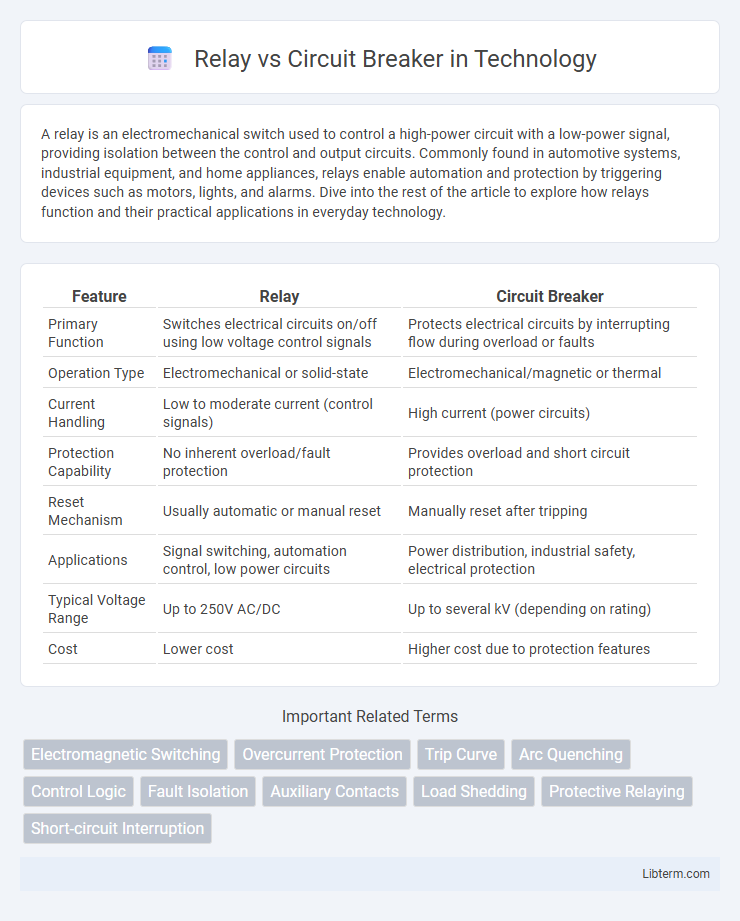A relay is an electromechanical switch used to control a high-power circuit with a low-power signal, providing isolation between the control and output circuits. Commonly found in automotive systems, industrial equipment, and home appliances, relays enable automation and protection by triggering devices such as motors, lights, and alarms. Dive into the rest of the article to explore how relays function and their practical applications in everyday technology.
Table of Comparison
| Feature | Relay | Circuit Breaker |
|---|---|---|
| Primary Function | Switches electrical circuits on/off using low voltage control signals | Protects electrical circuits by interrupting flow during overload or faults |
| Operation Type | Electromechanical or solid-state | Electromechanical/magnetic or thermal |
| Current Handling | Low to moderate current (control signals) | High current (power circuits) |
| Protection Capability | No inherent overload/fault protection | Provides overload and short circuit protection |
| Reset Mechanism | Usually automatic or manual reset | Manually reset after tripping |
| Applications | Signal switching, automation control, low power circuits | Power distribution, industrial safety, electrical protection |
| Typical Voltage Range | Up to 250V AC/DC | Up to several kV (depending on rating) |
| Cost | Lower cost | Higher cost due to protection features |
Introduction to Relay and Circuit Breaker
Relays are electromechanical switches that control circuit flow by opening or closing contacts in response to electrical signals, commonly used for low-power control applications and automation systems. Circuit breakers are safety devices designed to automatically interrupt high-current electrical circuits during overloads or short circuits to prevent damage and ensure protection. Both devices are integral to electrical systems, with relays primarily managing control functions and circuit breakers providing essential protection.
Fundamental Concepts: What is a Relay?
A relay is an electromechanical switch that uses an electromagnetic coil to control the opening and closing of electrical contacts, allowing low-power signals to control high-power circuits. It functions by energizing the coil to create a magnetic field that moves an armature, which in turn opens or closes the circuit. Relays are essential for isolating control and power circuits, providing protection and enabling automation in electrical systems.
Fundamental Concepts: What is a Circuit Breaker?
A circuit breaker is an automatic electrical switch designed to protect an electrical circuit from damage caused by overcurrent or short circuits by interrupting the flow of electricity when a fault is detected. It operates by mechanically opening the circuit to stop the current flow, preventing overheating, fire hazards, and equipment damage. Unlike relays, circuit breakers provide both protection and control functions with the capability of manual or automatic reset.
Key Differences Between Relays and Circuit Breakers
Relays and circuit breakers both serve as protective devices in electrical systems, but they differ significantly in function and application. Relays primarily act as control devices that detect electrical faults and send signals to trip circuit breakers or other equipment, whereas circuit breakers physically interrupt the electrical flow to protect circuits from overcurrent or short circuits. Key differences include the relay's role in fault detection and control versus the circuit breaker's function as a direct switching and interrupting device, with circuit breakers designed to handle higher current interruptions and provide manual reset capabilities.
Working Principles: Relay vs Circuit Breaker
Relays operate by using an electromagnetic coil to open or close contacts, allowing them to control circuits by detecting variations in current or voltage and responding accordingly. Circuit breakers function by automatically interrupting electrical flow when they detect overloads or short circuits, employing thermal or magnetic mechanisms to trip the contacts and prevent damage. While relays primarily act as switches controlled by electrical signals, circuit breakers combine switching and protective functions to ensure electrical safety by breaking circuits under fault conditions.
Common Applications in Electrical Systems
Relays are widely used in low-voltage control circuits, automation systems, and signal switching due to their ability to control high-power devices with low-power signals. Circuit breakers are essential in electrical distribution systems, industrial plants, and residential wiring for protecting circuits from overloads and short circuits by interrupting current flow. Both devices ensure system safety and reliability but serve different functions, with relays primarily for control and circuit breakers for protection.
Advantages of Using Relays
Relays offer advantages such as precise control over high-current circuits using low-current signals, enabling efficient isolation between control and power systems. Their fast switching capabilities enhance response times in automation and protection applications. Furthermore, relays provide flexibility with various configurations like electromechanical, solid-state, and automotive types, catering to diverse electrical system requirements.
Advantages of Using Circuit Breakers
Circuit breakers offer precise overload and short-circuit protection by automatically interrupting electrical flow, minimizing equipment damage and fire risk. Their ability to be quickly reset after tripping reduces downtime compared to fuses or relays that may require replacement. Advanced circuit breakers provide adjustable trip settings and integration with smart grid technologies, enhancing system reliability and operational control.
Factors to Consider When Choosing Between Relay and Circuit Breaker
When choosing between a relay and a circuit breaker, consider the load type, voltage level, and application requirements to ensure optimal protection and control. Relays are ideal for low-power signal switching and precise control in automation systems, while circuit breakers provide robust protection for high-current electrical circuits by interrupting fault currents. Evaluate factors such as response time, current rating, resetting capabilities, and environmental conditions to select the appropriate device for safety and system efficiency.
Conclusion: Which is Right for Your Application?
Choosing between a relay and a circuit breaker depends on your application's specific requirements for protection, control, and reset functionality. Relays provide precise switching and control for low-voltage circuits, ideal for automation and signal isolation, whereas circuit breakers offer reliable overcurrent protection and automatic disconnection in power distribution systems. Evaluate factors such as voltage level, load type, response time, and safety standards to determine the best fit for your electrical setup.
Relay Infographic

 libterm.com
libterm.com